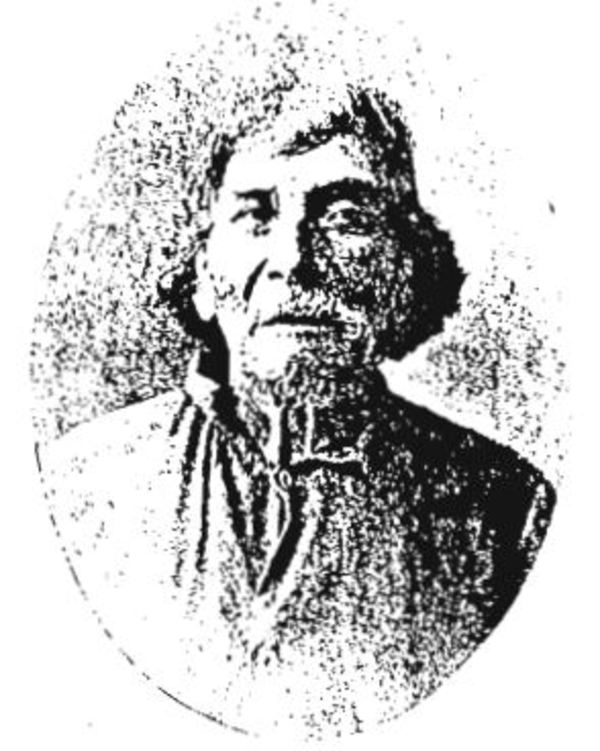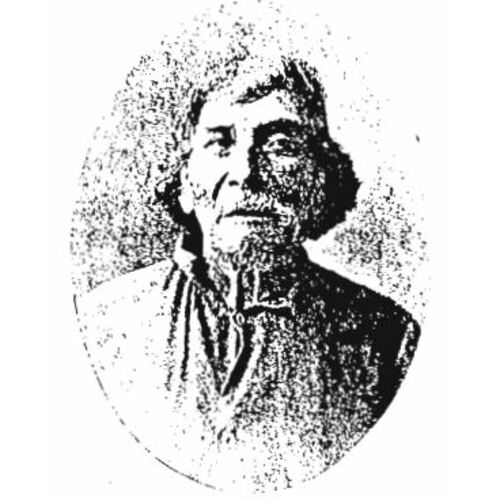
Source: Link
BEAR (Bair, Muin, Aubin?), NOEL (Noil, Newell, Newal), Maliseet hunter, trapper, guide, and basket-maker; b. on the Mattawamkeag River (Maine), son of Peter Bear and a Saint-François Abenaki woman; perhaps m. first a Penobscot woman; m. 4 Nov. 1851, in Woodstock, N.B., Monica (Moneech) Francis, who may have been a Micmac woman of Red Bank or Richibucto, N.B. (d. before 1896), and they had three sons; d. 4 Sept. 1907 on the Tobique River, N.B.
On his father’s side Noel Bear was descended possibly from Jean Serreau* de Saint-Aubin, a French seigneur in the Passamaquoddy Bay area, whose son Charles married a Maliseet woman about 1690. Noel’s great-great-grandfather Chief Pierre (Peter) Saint-Aubin of Meductic (near present-day Meductic, N.B.) may have been a son or grandson of this marriage. Pierre is reputed to have been the first to use the name Bear because of his shaman’s power to locate bears. Noel’s grandmother’s family on his father’s side was originally from the Kennebec River (Maine) and, according to family tradition, had survived the attack on Norridgewock (Narantsouak; now Old Point, Madison, Maine) by Massachusetts troops in 1724 [see Jeremiah Moulton*].
Meductic had been, at least since the end of the 17th century, the site of the major village of the Maliseet of the Saint John River region. With the arrival of Father Charles-François Bailly* de Messein at Aukpaque (Savage Island, N.B.) in 1767 and the death of Chief Noel Tobig (Toubic) of Meductic in the same year, the village seems to have been abandoned. For the period of Bailly’s stay and his subsequent visits the Saint-Aubins appear regularly in church records at Aukpaque. During the American revolution they sided with the rebels at Machias (Maine) under the leadership, until his death in 1780, of Noel’s uncle or great-uncle Ambroise Saint-Aubin*. Indeed, Saint John River Maliseet figured as the majority of Indian partisans of the rebel cause in the Passamaquoddy area.
After the revolution some Saint-Aubins continued on at Passamaquoddy under the leadership of Ambroise’s brother Joseph-Thomas Saint-Aubin*. Because of their support for the rebels they believed they would be included in the Passamaquoddy Treaty of 1794. In all likelihood they were the family of Bears who, according to an oral tradition among the Passamaquoddy, inhabited an island near the present Passamaquoddy village of Peter Dana Point until they were ravaged by a smallpox epidemic. It may have been there that Noel’s parents sought refuge and undisturbed hunting once the loyalists had invaded their Saint John River territories. Noel was born nearby, on the Mattawamkeag River, probably around 1796 although various later dates are suggested by census and other records. In the 1900 census of the United States he would be listed as of Passamaquoddy parentage.
Since American officials deemed Maliseet of the Saint John River to be residents of British North America, they were not allowed a share in the benefits of the Passamaquoddy Treaty, in spite of the fact that they had hunting territories in what is now northern Maine and in spite of their participation in the revolution. Hence the Bears/Saint-Aubins seem to have drifted off to more isolated hunting areas. Noel remembered being carried by his mother on snowshoes from the Miramichi River in New Brunswick to the mouth of the Tobique River when he was only five, and before there was any settlement at Tobique (Indian) Point. This journey perhaps took place in 1801, when lands were first set aside for the Maliseet at Tobique [see Noël Bernard*]. Noel’s father and uncle Ambrose were later known to hunt and trap on the headwaters of the Tobique, but they were in fact more wide-ranging. In 1811 Noel and his uncle met the first settlers at what was to become Houlton, Maine. Noel’s name is found on a petition signed by the Penobscot at Old Town, Maine, in 1831, and during the “Aroostook war” (1838–39) he was employed by soldiers at Fort Fairfield in Maine to supply moose to the garrison.
Noel first appears on a census list at the Tobique Indian Reserve in 1853, about the same time that Maine’s hunting laws started becoming more stringent for all except the Penobscot and Passamaquoddy, who had treaties with the state. He subsequently figures from time to time in censuses of Tobique and more regularly in petitions complaining of encroachments on Maliseet lands there. His name appears on two of the three questionable surrenders of lands at Tobique that took place in the 1890s; by this time, however, a much younger cousin of the same name had come of age, and it may have been he who signed the surrenders. Noel Sr is listed once more on a census before his death. In 1900 he was a widower living in Houlton with his sons Peter and Thomas.
From all accounts Noel was more traditional than Catholic in his beliefs, a fact borne out by the almost complete lack of church records on him, except for his marriage and burial notices. He does not appear to have cultivated any land at Tobique as did so many others. Instead, he remained the quintessential hunter, ranging regularly from the Miramichi and Tobique rivers to the waters of the Allagash and the upper Saint John in Maine and to those of the St Lawrence. Even Tobique Maliseet marvelled at his bear-like ability to survive in the woods from fall to spring and referred to him and his sons as “all same muin (bear).” Before 1870 he, his uncle and son, and two other Maliseet were reputed to have killed all the moose in their territory and sold the hides in Quebec. It is possible that he and his eldest son were the Noel and Peter who guided army officer Richard Lewes Dashwood from the Restigouche River to the Tobique headwaters and on to the Miramichi in 1862.
In the 1870s and 1880s a burgeoning demand for meat, hides, and furs encouraged hunting for market purposes and led to the widespread slaughter of game. The same period saw a phenomenal growth in sportsmen’s clubs based on a new conservation ethic and the idea of the “gentleman hunter.” Now influenced by powerful sportsmen’s lobbies, both Maine and New Brunswick saw profits to be made from sports hunting and enacted increasingly restrictive game laws with harsh penalties for violators. Together with the scarcity of game, this policy had disastrous effects on the traditional Maliseet way of life. It is thus not surprising that in 1897 Edwin Tappan Adney* and others found Noel “grouchy and distinctly ugly towards whites.”
In his last years Noel was well known as a basket-maker around Houlton, Ashland, and Presque Isle in Maine, but he much preferred to hunt, claiming that basket-making was “only work to get food.” As late as 1903 he was still seen hunting on the headwaters of the Tobique. Although he spoke only broken English, he is reported to have said that “[the Indian] did not . . . go . . . through the world taking what belonged to other men and dying before his right time had come; he only wished to die quietly where he was and live where his fathers lived and as they did.” In 1907 Noel died alone in the woods, possibly as old as 111, and was buried at Tobique.
A sketch of Noel Bear by Edwin Tappan Adney and a photograph of Noel in his camp appear in Adney’s papers at the Peabody Museum (Salem, Mass.), box 56 (mfm. at UNBL). A painting of him, also by Adney, is reproduced on the dust cover of G. F. Clarke, Someone before us: our Maritime Indians ([2nd ed., Fredericton], 1970), and in Alden Nowlan, “Dr. George Frederick Clarke: an appreciation,” Atlantic Advocate, 60 (1969–70), no.2: 33. A photographic portrait, originally a postcard, entitled “Newell Bear, Aroostook’s oldest Indian, very likely the oldest Indian living in the United States; 108 years old; Houlton Me.” is preserved in the Univ. of Maine at Presque Isle Library, Aroostook County Hist. Coll., and has been published in the works cited below by Thibadeau, facing p.11, and Wherry, p.552. Another photograph, showing Noel making baskets, appears in Maine dirigo: “I lead”, ed. D. B. Bennett and B. E. Young (Camden, Maine, 1980), 132, and Andrea Bear Nicholas, “The spirit in the land: the native people of Aroostook,” The county: land of promise; a pictorial history of Aroostook County, Maine, general ed. Anna Fields Mcgrath (Norfolk, Va, 1989), 35. A group photograph of Noel and two other Maliseet, all aged about 100, is in the Canadian Museum of Civilization (Hull, Que.), Photograph Coll., NM77-6514.
Canadian Museum of Civilization, Laslo Szabo coll., “Malecite stories,” 5: 458–60 (“Grave Island,” account by Lilly Gabriel) (typescript, 1975). Indian and Northern Affairs Canada (Ottawa), Protected Bands, B 8260-108 (new ser.), vol.7, Tobique petition to Manners-Sutton, 8 Aug. 1861. Maine State Arch. (Augusta), Council report warrants, no.456. NA, RG 10, 2110, file 20295, pt.1. N.B. Museum, W. F. Ganong papers, scrapbook 5: 200–1 (“Noel Bear, Indian,” undated clipping from the Boston Herald, c. 1905). PANB, RS9, 27 Feb. 1857, no.1; RS105/1868/61; RS266, A13c; RS557/1853/3; RS570, A1, 1869. Peabody Museum, E. T. Adney papers, boxes 36, 56, 61, 64 (mfm. at UNBL). St Anne’s Roman Catholic Church (Maliseet, N.B.), RBMB, esp. vol.1: 162c (Edith O’Brien, “Names of inhabitants of the Tobique Indian village in 1896,” 3 Feb. 1896). St Gertrude’s Roman Catholic Church (Woodstock, N.B.), RBMB, 4 Nov. 1851. UNBL, MG H22, box 1, file 4, no.19. U.S., Bureau of the Census, Personal census service branch (Pittsburg, Kans), Twelfth census of the U.S., 1900, schedule no.1, Indian population: A37. Univ. of Maine at Presque Isle Library, Aroostook County Hist. Coll., W. T. Ashby, “A complete history of Aroostook County and its early and late settlers” (typescript copy of a series of articles in the Mars Hill Gazette (Mars Hill, Maine), December 1910–December 1911), c.XII: 68–72. [A much embroidered account of Noel. a.b.n.]
G. F. Clarke, Six salmon rivers and another in Canada (Fredericton, 1960). R. L. Dashwood, Chiploquorgan; or, life by the camp fire in Dominion of Canada and Newfoundland (Dublin, 1871), 36–62. E. D. Ives, George Magoon and the down east game war: history, folklore and the law (Urbana, Ill., and Chicago, 1988), esp. c.3. H. M. Manzer, “Around the campfire,” University Monthly (Fredericton), 4 (1884–85): 98–100. F. G. Speck and W. S. Hadlock, “A report on tribal boundaries and hunting areas of the Malecite Indian of New Brunswick,” American Anthropologist (Menasha, Wis.), new ser., 48 (1946): 360–61. W. J. Thibadeau, The Irishman: a factor in the development of Houlton; a history of the parish of St. Mary’s; a word about the Acadians of Madawaska (Augusta, Maine, [1910?]) (copy in the New England Historic Geneal. Soc. Library, Boston). James Wherry, “The history of Maliseets and Micmacs in Aroostook County, Maine: preliminary report number two, June 1979,” and “Leadership in Maliseet society,” U.S., Senate, Select committee on Indian affairs, Proposed settlement of Maine Indian land claims: hearings, 96th congress, 2nd session, on S. 2829 . . . July 1 and 2, 1980, Washington, D.C. (2v., Washington, 1980 (i.e., 1981]), 2: 506–609 and 610–22, esp. 619.
Cite This Article
Andrea Bear Nicholas, “BEAR (Bair, Muin, Aubin?), NOEL (Noil, Newell, Newal),” in Dictionary of Canadian Biography, vol. 13, University of Toronto/Université Laval, 2003–, accessed January 18, 2026, https://www.biographi.ca/en/bio/bear_noel_13E.html.
The citation above shows the format for footnotes and endnotes according to the Chicago manual of style (16th edition). Information to be used in other citation formats:
| Permalink: | https://www.biographi.ca/en/bio/bear_noel_13E.html |
| Author of Article: | Andrea Bear Nicholas |
| Title of Article: | BEAR (Bair, Muin, Aubin?), NOEL (Noil, Newell, Newal) |
| Publication Name: | Dictionary of Canadian Biography, vol. 13 |
| Publisher: | University of Toronto/Université Laval |
| Year of publication: | 1994 |
| Year of revision: | 1994 |
| Access Date: | January 18, 2026 |



